Trust me, I'm in advertising...

10 years ago when I started my own agency, an account director mate left the industry to become a real-estate agent. I remember thinking it was the only place he could go that had a lower standard of trust than we advertising types.
Last week he told me it was a great move financially, he reckons 99% of people in advertising are really smart, whereas he’s happy competing with the 99% of real estate agents he’s found to be really ordinary. If we are that smart, why can’t we lift our own profile, beyond the bottom of the heap for trusted professions?
Trust in advertising? This is not an oxymoron.
Unfortunately, the perception of our industry is on a par with used car salesmen, yet our legal obligations, indeed our personal liability, dictate our practices are squeaky-clean.
In Australia, like most things, our industry is regulated and kept on the honest path by a series of laws and regulatory bodies. You wouldn’t know it.
The 2011 senate inquiry into outdoor advertising standards found only 0.01% of ads were found to be bad, i.e. sexist, likely to offend or straight out untruthful. Yet when prompted on ABC radio, the senator leading the inquiry said that if we don’t clean up our act under self regulation, he’ll "pull out the big stick and regulate" us.
Would you trust a politician to decide whether marketers are trustworthy?
In Europe, clergy are experiencing a decline in confidence levels and politicians are in last place. Our peers don’t rate much better than we do here, with over half of Europeans surveyed* saying they don’t like journalists, marketing specialists or advertising experts.
*Source: GfK Trust Index in spring 2010
I can understand why journalists are suddenly on the nose – the phone hacking scandal at Rupert's tabloid News of the World has in the words of one shareholders action group "laid bare a striking lack of stewardship and failure of independence." The board had been unable to set a "strong tone-at-the-top" about unethical business practices.
Australians generally are a trusting lot. When it comes to believing what our fellow citizens say, Australia on a trust index score of 92 ranks ahead of the U.S. (78.8) and U.K (61), just behind New Zealand (102) and way behind China on 120.9.

Source: ASEP/JDS data bank 2011
So where do Australia’s “ad people” sit on the trust index today?
Who we really trust is no real surprise:
1. Paramedics
2. Firefighters
3. Pilots
4. Rescue volunteers
5. Nurses
At the bottom of the pile are
41. Taxi drivers
42. Real estate agents
43. Car salesmen
44. Politicians
45. Tele-marketers
Source: Readers Digest Austrlalia’s most trusted professions poll 2011
Before you think ad madmen aren’t so bad after all, the only reason they’re not last on this list is because they aren’t included in the survey. Tele-marketers are the closest category, so let’s just accept advertising and marketing guys are way down there. How did we end up down at the bottom with pollies, and what do we need to do to elevate our role to a similar level of respect as other service providers like engineers, doctors and architects?
Advertising first took off in America in 1800s when snake oil makers discovered the return on investment of promoting something of little value with amazing claims in the press. In Australia last year the most damage to our credibility was the public complaints about the posters advertising Advanced Medical Institute’s cure for under performance in bed. It was bad enough they were bad ads, the real breach of trust was the pitch was a fraud. Most of those with a desire to last longer in bed were overcharged for a treatment that generally didn’t deliver on the promise.
As a professional I feel we would be better off refusing to work for these types of people. It didn’t harm Bill Bernbach’s career when he told prospects he wouldn’t accept their business if their product didn’t live up to his standards.
(Glenn Mabbott would like to declare his interest as a sitting member of The Communications Council’s Policy Committee, which aims to raise industry standards through the Accreditation Scheme. UNOmarcomms was one of the first independent agencies in Australia to gain accreditation.)
Are today’s retail ads bland, bland, bland?

Are today’s retail ads bland, bland, bland? This was the question posed by AdNews last week after Dick Smith launched a new brand style ad campaign. If you missed it, here is a cut down of my contribution to the debate.

Dick Smith was an innovator
He built a new category with advertising and brochus that gave Australia’s cardigan wearing tinkerers access to an Alladin’s cave of electronics stuff to play with in their garages. What proved Dick really clever was his ability to sell his growing challenger brand to Woolworths and then go on to innovate time and again. With Australian Geographic and then his Australian Made products, Dick was a natural at creating marketing campaigns that resonated with the public mood of those times.
Contrast this with another retail innovator of Smith’s era, Gerry Harvey. Gerry also made his first million in his early twenties with ads for whitegoods and appliances that yelled, “Why pay more?

Is Gerry a clever Dick?
Gerry didn’t sell his business and continues to be the biggest retail advertiser in the country with ads that follow the same tired formula of thirty years ago. We all know the pitch: yell loud enough and people will rush in to grab a bargain. Except increasingly we’ve learnt to treat those ads as repetitious nagging. We’ve moved on to better retail experiences, which are likely to be online.
It’s time the majority of retailers looked at the current crop of retail innovators, like Net-a-Porter that has just released a new magazine iPad app that makes shopping an exciting, contemporary experience. Or this great campaign in Korea for Tesco’s challenger brand, Home Depot.
This article first appeared in AdNews, 21/10/11
A lateral way to increase retail shelf space: use a billboard
Watch this short video of how Tesco challenged the number 1 retailer in Korea by creating a virtual store.
What’s the next killer app?
The latest stats show Australians are the number 2 adopters of smartphones. And this year, Tablets and iPads are set to outsell mobiles, Australians will buy 1.2 million of them*. In the last couple of years the fastest increase in marketing online has been with using video, so we believe the next big thing for marketers will be video over smart mobile devices.

Ask us about the app factory that will let you make the most of video content. (Soon to be launched by UNO with our partners at Mass Media Solutions.)
*Telsyte mobile device update 2011.
73% of CEOs think marketers "Lack Business Credibility"
According to damning research by the Fournaise Marketing Group, marketers are not the business growth generators they should be.*
The gist of the findings of an Asia wide survey of CEOs is that management believe their own marketing departments are in a world of their own. They believe marketers speak in jargon and are not contributing any value to the business. From my experience you can’t blame most business owners for thinking this way, especially in Australia. Too few businesses have ever had a good marketer sitting round the table at board level, championing the power of marketing to generate wealth.
Marketers need to talk the language of business outcomes
As in “how can marketing get a better return on investment”. Otherwise marketing will remain a misunderstood black art not worthy of the attention of three quarters of CEOs. The vast majority of businesses will thus miss out on the huge opportunities that insightful marketing can deliver when it is woven through the entire business process.
Meanwhile there are a handful of businesses doing better than the rest because they have value-adding marketers on the team. These marketers, obsessed with return on investment, are recognised as an integral part of the senior management team. They are helping their businesses punch above their weight in the following ways…
- Overcome competition based purely on price
- Prevent decline of sales
- Hold on to existing customers
- Build qualified sales leads
- Change the perceived quality of a product
- Revitalise tired brands
- Boost staff morale
- Speed the development of new markets
- Speed product trial and acceptance
- Help businesses raise capital more easily
- Build the value of a business for sale
ROI marketing works
For 100 years Coke has proven it, people from first world countries to third choose Alabama’s black sugar syrup even though it doesn’t taste as good as Pepsi’s. That’s the power of consistent marketing. Perrier taught us to pay more for mineral water than petrol. Branson has convinced Australians to fly Virgin despite having a deplorable record of taking off late, (and you still have to pay for your sandwiches). And thanks to marketing Apple has built a brand that is hugely profitable, marketing has enabled them to sell often inferior spec’d products at a premium to specialist manufacturers like Nokia and HP.
CEOs needn’t fear marketing speak. Business decision makers who embrace marketing with an open mind can still enjoy a sense of control by implementing a test and learn approach. Any marketer worth listening to understands the value of having the results of their work tracked. If it isn’t measured, it isn’t managed. A marketing program that IS managed WILL deliver better results than mindlessly sticking to what the company has always done, or jumping blindly into the latest thing.
ROI Marketing can make a big difference to any sized business, in any category
So what can ROI marketing do for you? My experience has shown me whatever the category, from Watties baked beans to Brita water, Splash Clinic cosmedical treatments to City Index CFDs, a test and learn marketing program can turn good businesses into category leaders.
Read MoreTwo thirds of Australians are using social media. Two thirds of those use it to decide what to buy.*
Social Media Marketing (SMM) is growing, the latest figures show Social Media is becoming a mainstream influence in the purchase decision process. UNO are members of the Australian Interactive Media Industry Association. Together with Sensis, AIMIA surveyed 803 Australian consumers and 1,944 Australian businesses to determine how social media channels are being used. 50% of corporations now have a social media presence, the majority on facebook. Just 14% of small businesses use social media.
Proportion who have Social Media presence

Proportion who have Social Media presence

Social networking site usage by age and gender

Here are 10 ways you can make more of Social Media in your marketing communications mix:
- Start now for free. If your business is consumer facing, get a facebook page, it’s free.
- For B to B, skip facebook. Focus where business decision makers are active. Join LinkedIn. Follow relevant associations and groups, join industry forums and post comments on articles.
- Share your knowledge. Your business is your passion; tell it how you see it where you can add value to a conversation. No need to sell, just build your credibility as an expert and you’ll be increasing the standing of your businesses.
- Don’t post as anonymous. Out yourself. The CEO of a solar hot water manufacturing company follows chatrooms where plumbers share advice. His comments to tradies‘ questions demonstrate he’s in touch with his market. I suspect his competitors are unaware such forums even exist.
- Put someone in charge of your Social Media. Empower a person within your business who is passionate and keen to have a dialogue with customers. If you don’t have anyone internally, outsource.
- Tweet. Reinforce your position as an industry expert by tweeting and re-tweeting about relevant content that others have shared.
- Blog. Blogs and reviews have a big influence on buying decisions, with 63% of social media users reading reviews before making a purchase decision.
- Be regular. Respond quickly.
- Integrate social media. Integrate content with your promotions and product campaigns. Measure. Track.
- Video is the future. It’s the fastest growing area online because it’s easy to share. It’s not enough to post a television commercial on YouTube because no-one will look for it. Be creative, film an interview with an expert, or shoot a behind the scenes glimpse that showcases something you do well.
Social Media can deliver a measurable ROI. No wonder businesses are spending 5% of their marketing budgets managing and creating content for social media.
The good news is that any business that has collected data on their customers is sitting on their own potential gold mine. Rather than spend money trying to appeal to new prospects by running press or even online ads, you will get a much better return on investment by adding some intelligence to the way you manage your data.
Give your CRM some Data Intelligence
Most data is in such a mess it offers little insight to business owners. To turn it into a powerful tool to enable you to communicate with your customers requires a clean, intelligently organised database.
The place to start to release the value from the mountain of data you already have is to give it to an expert to wash it.
You’d be surprised how many emails and addresses are wrong, repeated or out of date. You can’t begin to measure response rates until you know the data you have is clean. It’s better to measure the response from 10,000 real customers than to assume you’re sending offers out to say 30,000 on a dirty list.
Once you have a clean list, your data then needs to be structured and categorized with the aim of maximising its usefulness for marketing purposes. There are then some things you can do straight away to not only deliver quick profits today, but also set you on the path to delivering what customers will want in the future.
Fast profits can come from testing and tailoring offers to:
- up-sell, getting customers to buy more valuable products from you
- cross-sell, encouraging them to add something else to what they usually buy from you
- increase purchase frequency, by building loyalty and giving them more reasons not to be tempted by your competitors
So get the experts in quick smart to professionally clean your data so you can secure the future of your business. Let those who continue to spend big to tempt new prospects pay the price.
Read More
What will it take for retailers to stay in business in this rapidly changing global economy? Futurist Ross Dawson commented in a recent blog that if you expect your business to look the same in 10 years as it does today, expect to be out of business.
Who’d have thought ten years ago that Woolworths would be the biggest owner of pubs and bottle shops today? Constant change is the only way to stay competitive, which explains why Woolworths just bought Cellarmasters for $340million. Kevin Luscombe recognises the future includes database marketing, Cellarmasters “will enable us to serve a whole new customer segment in terms of the direct marketing channel.”
eCRM drives online sales
Cellarmasters has the largest databases of drinkers of premium wines in Australia. For any competitor to stay in the premium wine business they’ll need to at the very least match the way they apply an eCRM program to their database.
Once a database has been professionally cleaned, you can start to mine your database and build a series of profiles of your customers. Using that intelligence will deliver a better ROI on your marketing. You’ll get a better result cross selling Pinot Gris to customers who are heavy purchases of Sauvignon Blanc. With profiles of your customers it becomes practical to promote a 20 case limited offer Coonawarra cleanskin, you simply email your regular purchasers of Cabernet. With data intelligence, while you offer a bonus with purchase of single malt to spirits drinkers, beer drinkers automatically receive a different offer.
Very few customers want to be constantly bombarded with promotions that are obviously being sent to the masses. They will reward targeted offers that demonstrate you understand them as an individual with stronger loyalty.
Your customers know what they like and will actually tell you what they want if you bother to track their behaviour, or quite simply ask them. Every marketing activity, from a mailer or catalogue to a visit to your store, each phone enquiry and every online order is an opportunity for you to measure what works and what can be improved.
ROI marketing will drive e-commerce
Every dollar you spend on marketing should and can be measurable. You don’t actually have to be a futurist to stay in business, with data intelligence you can keep track of where your customers’ needs are leading and continuously adjust and improve to keep up with them.
Read More
Bernard Salt earns a living as a demographer. That’s the art of taking research data and painting a picture of who we are and what we think and do. Before you tune out thinking he’s just another propeller head making money off the back of lies, damn lies and statistics, consider for a moment what you’d give as a business to know where the next big opportunity for making money is, before it happens.
How do entrepreneurs know where to invest today in what will be the sweet spot tomorrow? What did the savvy few who bought franchises in McDonalds in the eighties know? Or the food services that were ready to be part of café culture as we left tea drinking behind?
If you were a tea manufacturer in the 70s Australia’s demographics could have predicted that your volumes were about to decline. The move from a society of tea drinkers to the blossoming of café culture at the turn of this century was a consequence of something that happened in the 1950s. The wave of immigrants from Italy and Greece post war had kids, grew wealthy and infused our Anglo society with a Mediterranean café culture which saw Australians move onto the footpaths and embrace machiattos and cappuccino with biscotti in preference to sitting indoors with a cuppa Bushells and an iced Vovo.
At a Family Business Australia breakfast, Bernard explained the simple truth that the composition of Australia is what drives business growth. And decline. Seems obvious, yet even the high fliers at BHP and the big four banks pay Bernard to keep them abreast of what should be self evident. It’s easier to grow a business and be profitable in a category of growing demand than to compete for a share of a shrinking one.
Change managment – there's money in tea
Follow the demographic trends that will shape what Australians will look like in the next decade and consequently what consumers will be asking for. Today there is a shift away from European immigration to Asian as these stats on fastest growth and loss by place of birth show.

Prediction: Start thinking about tea and noodles not coffee and pasta.
Super was yesterday’s money maker
In the last decade the biggest growth in financial services has been in superannuation. The SMSF category has doubled its share to be the largest segment at huge cost to growth of retail funds as boomers take more interest in their money in super. Industry funds have also grown share with a low fee proposition and the locked in stream of contributions via the super guarantee levy from a membership base that traditionally wasn’t saving much. But that’s today’s boom business, tomorrow it will change, again because of a shift in demographics.
The makeup of working Australia is about to fall off a cliff, as the boomers retire and are replaced by… no-one:

The age at which boomers will retire, now on average 58, as well as the length they can expect to live has also profoundly changed in just a generation:

Prediction: Cashed up retirees who will live for 20+ years will want to travel, eat out, be entertained, live in a city apartment or by the sea and to pay for it all need a retirement pension plan that will last the distance. They’ll be looking at ETFs and annuities.
Bernard Salt has a pretty good idea of what tomorrow looks like. It’s up to you to see how you can position your business today to be ready to reap the rewards of a growing market category before it’s the next big thing.
Read MoreDoes your business have a brand policeman?

When did you last check your brand imagery and how consistently you are projecting your business to customers and stakeholders? Have you done a complete audit of all your “touch points”? Who in your company has the authority to enforce standards?
Large corporations have entire departments looking after how the image they present visually. They have realised the value created by consistent repetition of the company brand marks alongside the product or service it delivers.

Most businesses fail to present themselves as professionally as big brands and end up with a brand “look” that has more in common with a camel than a racehorse. This occurs organically, by allowing too many people to make piecemeal decisions every time something is needed.
There are so many pieces that make up the complete picture of your brand, from a new business card to printing a brochure or sending an email offer. Each is an opportunity to build brand “credits”, or a risk for someone to go off on a tangent.
A complete audit of all your brand “touch points” would cover:
• Internal signage
• Building signage
• Banners
• Vehicle signage
• Advertising
• Email signatures
• Website
• eNewsletter templates
• Fax formats
• Letterhead
• Business cards
• Presentation folders
• Flyers
• Sales force and sales kits
• Product sheets, warranty forms
• Order forms
• Invoices
• Branding on your products
• Point of sale
• Price tickets and notices
Setting brand standards with a professionally developed Style Guide
Brand guidelines (also called a Style Guide) should cover all of the things in the list, and have specific rules for each element. For instance, how your logo is used would cover these specifications:
Colours
• Print: CMYK or Pantone reference
• Digital: RGB
• Mono, reverse,
• Vector files for artwork production.
Size guidelines - how small can it still reproduce?
Usage guidelines - clear space, location on the page, hierarchy with other symbols.
A Graphic Designer with credentials in this area can produce your Style Guide.
Enforcing your brand style
Your creative agency can act as your deputy and arm you with a password protected online archive of logos, images, artwork formats and templates.
Many businesses also find having a professionally developed Style Guide available, as a reference document for staff and suppliers, helps enforce brand rules making it easier to keep the company image under control.
Finally, someone qualified within your company needs the power to enforce the Brand guidelines. It is possible to mandate that all work using the company brand mark is approved by this person before it goes into production.
Success through consistency
Every business can benefit from designing formal brand “rules” so they can weave simple and consistent imagery through the company’s everyday operations. If you have a good product your customers will come to associate that product with your consistently delivered brand mark.
Read More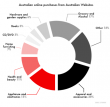
There’s more to ecommerce than GST
Funny how Harvey Norman and other retailers are running to the regulator with the sob story that they are losing sales to overseas online providers who don’t pay GST. Time for a reality check, they are losing sales because they are slow in changing their business models to keep up with consumer behaviour. 6 months ago I flagged the stats showing how quickly online sales were growing and the failure of our retailers to keep up with the trend.

Consumers reward innovation
It’s how Gerry Harvey made his first millions when, in his twenties, he founded the first category killer electrical discount store, Norman Ross. You don’t have to be young to be innovative; you just have to give consumers what they want in new and exciting ways. Today consumers increasingly are researching and shopping online. In a few years what they want will be something most of us have yet conceived, and more than likely Apple’s Steve Jobs, aged 55, already has in development.
Facebook keeps growing. So how can you make the most of it?
Facebook has broken through the 10 million barrier of active users in Australia*
While this will prompt many to jump in and increase advertising on Facebook from the current $12million a year, content is the cost-effective way any marketer can gain exposure to this increasingly significant audience. Best make sure it's the right kind of content.
Online content is King
When publishers and marketers say content is king, what exactly do they mean? Here’s an example close to my home. When I was 20 I played occasionally in a punk band called The Coathangers. Most nights we were lucky to get paid in free beer, the cover charge might be a couple of bucks. One night we had 6 bands for 69c. It was accepted that routine you played for little or no immediate return to build up an audience. Later you would then sell records to them, which was where the money was. Your loyal following paid for content.
Today you can’t expect to sell many CDs when everyone can download your content for free. My 21 year old son has a new band, The Psychonaughts. They hardly ever play live, they are busy recording, creating content that will more than likely be given away. In the not too recent past a band would build a website that fans would visit to purchase songs and buy merchandise. Not any more, people expect everything online to be free.
So what’s the value of giving away content online?
In the case of music, the content gets passed around and builds an audience, who then pay to see you perform live. Technology has turned the model upside down.
The ease with which people can share content across social media is a lesson for brands – we are now in an era where you have to produce content of value to your target audience, making it available for free. It then requires like-minded prospects to share it by whatever medium they choose: YouTube, mobile-to-mobile, email, or increasingly, Facebook.
According to Facebook regional vice-president A/NZ Paul Borrud, globally two-fifths of the more than 500 million Facebook users are accessing the site through their mobile. And Australians spend longer on the site than anyone else.
Unlike marketing via your brand site, or Google adwords, or banner ads or traditional mass media advertising and PR, the consumer isn’t being paid to publish your message. For content to be spread it isn’t enough to post brochure copy or press releases, content needs to be engaging stuff that your customer sees value in. And by aligning this free content with your brand story you can build a relationship with prospects stronger than an advertising approach could ever achieve.
So the art is producing content that is worthy of the attention of your audience, something they want to share.
* SMH.com.au 10/12/10

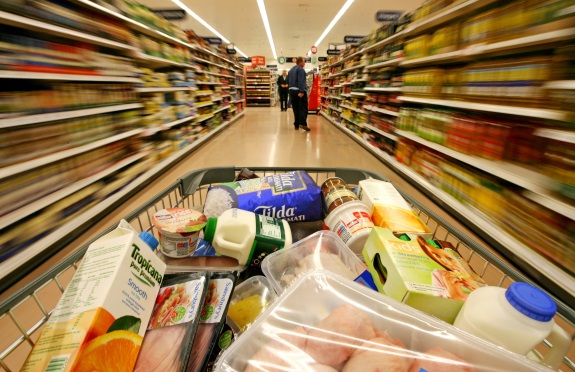
Over 70% of FMCG categories are predetermined before shoppers enter the store. Most of the items bought in supermarkets are already determined by routine before the shopper walks down the aisle. Yet there's a massive opportunity for 28% of the product purchases where impulse purchasing still reigns. The question is, what categories do shoppers engage with instore?
The Nielsen Category Shopping Fundamentals survey shows more people go to the supermarket to buy milk (57%) than any other item. Now you know why Coles launched its massive $1 a litre own brand milk campaign to grab share from Woolworths. Yet milk is one of the least considered decisions shoppers make at point of sale. Over 70% of shoppers aren't engaged by the category in the store.
It's a similar story for pet food and toilet paper. If you're a marketer of these low engagement instore categories you will get a better marketing ROI from a brand advertising campaign or an incentive before people go shopping.
Low engagement products don't benefit well from instore merchandising
Prospects who are less interested in your product instore are best marketed to out of store. From flyers to shopper dockets, catalogues to mobile promotions driving people to the store you will have better impact than attempting to get their attention while on autopilot in your category aisle. Packaging and instore merchadising is also less likely to switch customers between brands than other categories where people are actually paying attention.
However over half the shoppers surveyed are engaged by the process of shopping, just not with every category. So it follows knowing which category a product falls into helps marketers decide where to best invest in marketing.
The high engagement FMCG categories are frozen snacks and desserts
Shoppers are more engaged by more indulgent purchases like frozen desserts (64%) and infrequent purchases like toothbrushes (64%). Here is a snapshot of what shoppers are looking at with their brains switched off versus on:
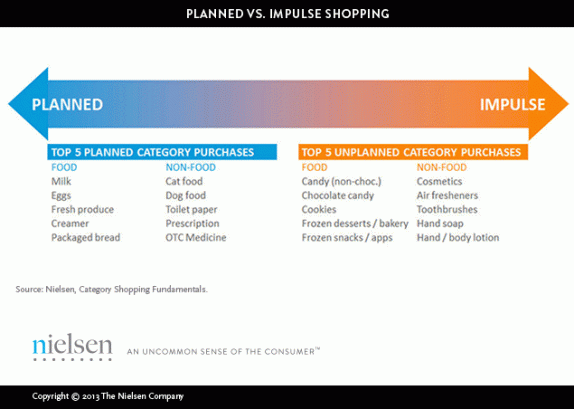
Categories with high engagement are better served by product innovation, instore merchandising and promotions and eye catching packaging.
Our marketing for Pacific West frozen seafood and snacks was centred on creating news and a fresh take on seafood. More adventurous choices has proven to be a more appealing strategy to the predictable product and positioning of Birdseye and I&J. Seven years of year on year growth for Pacific West shows what a difference it makes when you leverage an engaged instore audience.
Read MorePugs & Kisses & Christmas Wishes

(Click to Play)
A sincere thanks to our friends and colleagues for sharing our journey in 2013, UNO’s 13th year growing challenger brands.
We wish you and your family (and all creatures great and small) all the best for 2014.
Once again rather than send cards, we are supporting four koalas through the caring efforts of The Koala Foundation.
Best wishes from the UNO family.
Read MoreAIDS ads that changed our lives: If it's not on, it's not on

Australia faced a big problem in the 80s: AIDS was killing us
In the late 1980s AIDS was spreading unchecked in Australia amongst sexually active adults with multiple partners, homosexual males and intravenous drug users. Most people had no idea how you could catch it and there was no known cure. The only certainty was if you found you had AIDS, it was a death sentence.

The first government advertising campaign to raise awareness of the issue had failed to address the spread of AIDS. While “The Grim Reaper” ads certainly gained attention, the messages had not connected with those at risk and had not changed unsafe sex practices.
Indeed the Grim Reaper had simply scared the general public, especially kids and older people, without offering a compelling safe sex message. In charge of the government's AIDS awareness task force, Ita Buttrose had acknowledged the mistake the Grim Reaper fear campaign had been. The agency responsible that she'd appointed was fired and we were asked to implement our campaign they'd originally passed over for the Reaper.
The creative solution: "next time you go to bed with someone, ask yourself..."
"...how many people are you really going to bed with?"
You can't scare people into doing what's good for them. In fact, it's human nature to reject being told what to do. The art of persuasion often begins with starting a conversation that acknowledges the audience's point of view. And builds from there with an undeniable logic.
This commercial for the first time educated the community it wasn't "other people" who got AIDS, it was potentially anyone who went to bed with someone for unprotected sex.
Shot by Ray Lawrence (who went on to direct Bliss, Lantana and Jindabyne) my AIDS "beds" ad was made before the era of computer generated images. We put 800 real people into 400 real beds in the largest space we could hire in Sydney, the old tobacco bond store in Moore Park. The campaign worked in achieving the brief of raising awareness and driving behaviour change amongst those most at risk. The managers at Ansell would report an uplift in condom sales with every burst of our ads.
It's not often in this business you get the opportunity to really make a difference for society. It's usually baked beans and banking products.
Over three years as lead creative communicator I helped develop a series of undeniable messages that were created for specific audiences. From mass market messages on TV and radio, brochures for distribution in health clinics, English as a second language ads in ethnic press to bus sides and gay street press, posters on beats and stickers on public toilet doors.
The “Beds” ad which asked “next time you go to bed with someone, ask yourself how many are you really having sex with?” gave a graphic explanation of the chain of infection. The “Tell him if it’s not on, it’s not on” ads empowered people to demand their partners wear a condom. On the back of dunny doors in pubs across the country you couldn't ignore the big sticker of a condom clad erect penis with the words: "cover yourself against AIDS"
The outcome: Australia led the world in stopping the spread of AIDS
The integrated advertising campaign successfully raised awareness of AIDS amongst those segments of society most at risk of infection. The messages also reassured those not at risk and transformed the public view from one of “victims of AIDS” to an empowering safe sex message.
The creative campaign was instrumental in educating the public and changing sexual behaviour to succesfully reduce the transmission of the AIDS virus. The leader of Australia's health sector tasked with stemming the epidemic acknowledged the strength of the campaign:
“The message in this war against AIDS is a tough one – we know it will be controversial but we are certain it is the right approach, and it is backed by the World Health Organisation.”
Professor Ron Penny, National AIDS Council, 1988
This AIDS campaign is still recognised around the world as the most effective of it’s kind
Read MoreObstacles to innovation: A jeweller’s tale


Have you read the retail sector is finally looking up? Unfortunately not for everyone.
A friend of mine is one of Australia’s leading luxury jewellers. This year his turnover is down 20% and the word in the trade is over two dozen high-end jewellers around Sydney are on the brink of closure. That’s a lot in such a niche category. What has served them well for decades has seemingly evaporated overnight.
Where have the sales gone? A few years ago no-one had heard of Pandora as a brand of jewellery. Australia is now Pandora's fouth biggest market in the world. Or have you heard of The Iconic as a place to shop for fashion? Last week The Iconic turned over $1,000,000 of online sales in one day.
The simple answer for retail is to go online, right?
My jeweller’s quandary is he opened an online store with a similar offer to his shop and failed to gain any incremental growth.
Global changes demand an innovative response
It’s not just small high-end jewellers suffering from change. The global super premium brands are suffering the curse of ubiquity, Louis Vuitton sales are plummeting despite the increase in purchases of luxury goods by the emerging Chinese millionaire class.
We are increasingly seeing fashion conscious style setters seeking designs from unknown startups, boutique designers that they can tell friends they’ve discovered. Being in the know has more credibility with peers than wearing what any person with a Platinum card can buy in any Gucci store, from Guangzou to Fifth Avenue, Sydney to Roppongi.
Big brands have difficulty innovating as they have an aversion to cannibalising their existing business. It becomes harder the bigger and more established you are, which fortunately gives Australian challenger brands an advantage. The barriers to innovation have been identified in a Australia wide research by the Australian Institute of Management:
What’s stopping Australian businesses innovating

My friend said he had come across an offshore maker of silver jewellery, gold plated with semi-precious stones that look amazing but only retail for $300 to $500. His fear is if he stocked them no-one would continue to pay $3,000 to $5,000 for his similar looking existing product.
My suggestion to my jeweller friend is to take advantage of his ability to be more nimble than a Tiffany. He isn't facing the number one barrier to innovation, a lengthy development time and there is a way he can try something new with minimal risk. If he quickly sets up a small online store under a different brand, he then has no reputation to lose and can test the appetite for this new product.
The ability to test the mix of product and price is easily done with an online store. I’ve written in the past about how we can learn from fashion retailers that are innovating for pricing advantage.
The study shows the upside to trying new ways by becoming an innovator in your category is huge.
Innovation leaders Vs laggers: business performance ratings.
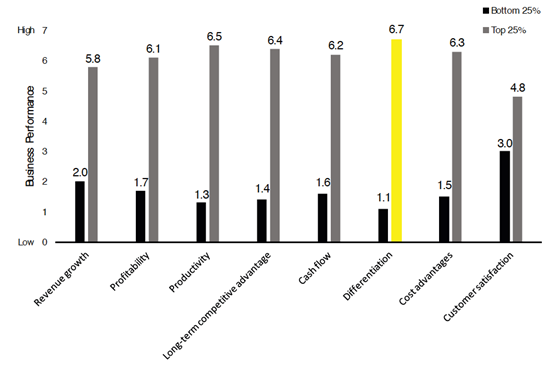
Innovation leaders are two to three times more successful than innovation laggers in terms of growth, profitability, productivity and cash flow. Risk obviously has greater rewards than business as usual. One UNO case study proves the point, Butterfly Silver was the first Australian Jeweller to apply a fashion forward procurement model to become a successful challenger brand.
Source: University of Melbourne and the Australian Institute of Management. 2013
Read MoreSales conversion rates: the facts

Sales call stats – how does your team rate?
48% of sales people NEVER follow up with a prospect.
25% of sales people make a second contact and stop.
12% of sales people only make three contacts and stop.
Only 10% of sales people make more than three contacts with a prospect
So if your sales people are typical of all sales forces, what are the consequences of only 10% of them calling on a prospect more than three times?
Conversion rates increase with sales call rates
2% of sales are made on the first contact.
3% of sales are made on the second contact.
5% of sales are made on the third contact.
10% of sales are made on the fourth contact.
80% of sales are made on the fifth to twelfth contact
Sure, it costs more for your people to call more than 3 times, but consider your return on investment when you factor in the typical conversion rates. Three calls and under only converts 10% of sales!
If your sales people are not following up, the stats indicate there is little to be gained by simply adding new names for them to visit. It also shows the value of building brand awareness before the sales person calls.
Source: Richter10. Thanks to Rick Allen for sharing
Why are most ads so bad nowadays?


Bartle Bogle Hegarty was the London ad agency every ambitious Australian creative wanted to work at in the 80s. They made a series of great ads for Levis including “laundrette”, came up with "Vorsprung durch Technik" for Audi, "The Lynx Effect" for Unilever and "Keep Walking" for Johnnie Walker whiskey.
BBH creative founder “Sir” John Heggarty will speak at a global advertiser conference in Sydney in March. He has already given an idea of what advice he has to for Australia's advertisers.
What is the state of advertising creativity today?
“It’s one of the best times ever to be in advertising but why is it the work is poor,” he told AdNews from his organic and biodynamic vineyard in France. “I don’t know of any other industry in the world that would say the way to succeed is to make a worse product. And we seem to be in that situation in advertising."
CEOs in Australia say they want creativity
More than anything else, a recent Australia wide survey of CEOs shows they want their marketing agencies to be creative. Yet one look around shows how poor ads are today.
The CEO of a financial services group asked me recently what killed the Australian ad industry? "The Internet?" he asked. "Globalisation" I answered.
The fact is, in Australia the biggest brands mostly run ads from somewhere else. They don’t care if their ads don’t work very well here, in the global scheme of things one year’s revenue in Australia can be surpassed in one long-weekend in Florida.
So I wasn’t surprised to see Sir John identify the cause of mediocre advertising. “You can talk about technology being the reason but for me the biggest issue is the globalisation of our industry. We don’t seem to be able to create work globally that has impact. I think marketers today are losing contact with people despite the fact they have many more ways of communicating with them.”
Meanwhile home grown ad standards are going down, down
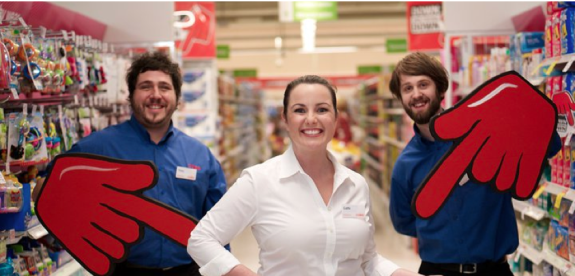
We are increasingly bomdarded with ads produced in-house by Australia's retailers, further driving standards down, down. Over 30 years creating ads has taught me great creativity sells. Especially when developed by local writers and art directors who are in touch with the essence of what makes Australians tick. I believe clients are best served by ads that tap into human insights, no matter how small. When told with humour or compelling gravitas a human truth will cut through where so called big ideas with big budgets and big name stars fail to connect with real customers.
Are you more inclined to buy from someone you like? I know I respond better to brands that have an endearing conversation with me, rather than a list of claims shouted at me, even when put to a jingle. The answer to appealing to customers doesn't lie in more data.
Sir John also warned about the dangers of data and analytics –
“Clients are desperate for salesmanship to be a science. They would love it to be. They would love to be able to say this equals that and this will be the return on investment so let’s do it. But they can’t. In the end it’s a judgment call you still have to make.”
Lets all hope more advertisers re-embrace the power of creative story telling, it makes better viewing.
Read MoreCustomer loyalty in Australia comes at a different price to O.S.

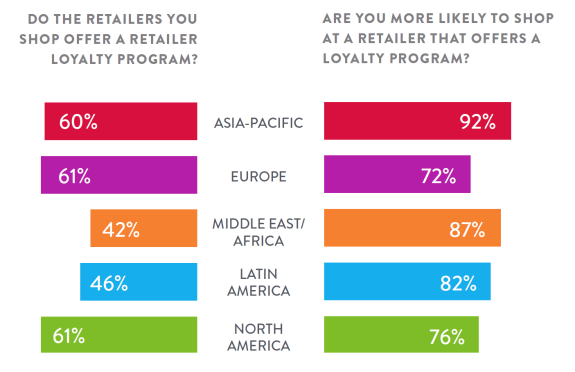
Our region ranks 1st in responsiveness to loyalty programs
We now have proof customers in the Asia-Pacific are the most willing in the world to reward businesses with loyalty. Whether you are in a service or product category, the good news for Australian business managers is your customers' loyalty doesn’t have to come at the price of discounting.
Don’t think global when marketing local
You can out-maneuver big brands that continue applying globally what works in their home market. Consider implementing strategies that Australian customers will reward with loyalty.
The US is introspective, remember it's the country that has a World Series with only US teams. Most US companies don’t have our local market's needs on their radar. Meanwhile, Europe’s big brands are struggling at home with a deflationary market. These parochial management mindsets offer Australian brands an unique opportunity. It's the perfect time to think and act local where big global players have a tendency to universally apply one strategy.
A global survey now shows us just how different Australian consumers are compared to the home town customers of global brands.
The Neilsen Global Report of Loyalty shows our customers are different
Unlike Europe and the US where 82% customers want discounts and free products as a reward, in our region we are less motivated (70%) than anywhere else by something for nothing. Here customers lead the world in valuing good customer service (53%) and exclusive deals (41%). The Customer Loyalty Report shows your customers want you to give them quality and service more than just price:
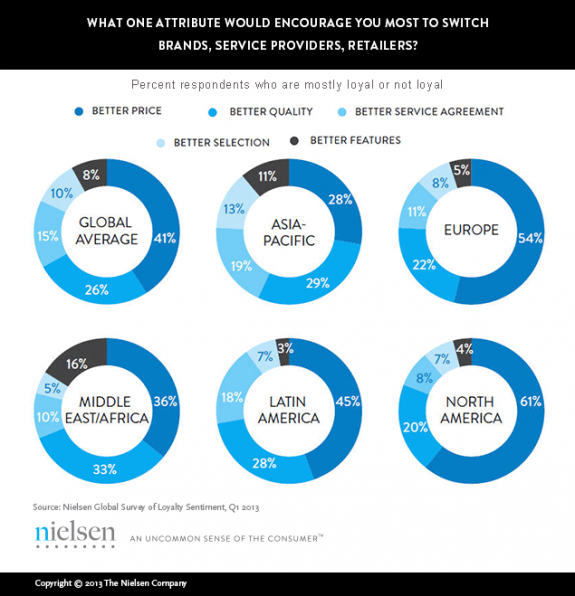
Loyalty programs can improve profits
UNO applied the disciplines of building a loyalty program around quality and service for Vivien's Jewellers. We replaced monthly cardboard in-window price promotions with quality themed creative store merchandising. We introduced a VIP loyalty program that emphasised exclusive product offers. Sales, discounting and price promotions were no longer frequent, being replaced with special occassion sales through invitation-only Wednesday night store openings. While Angus & Coote and Michael Hill were seen to be always on sale, we built a reputation for accessable aspiration.
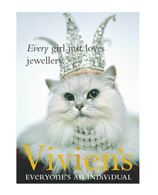
Over 5 years we transformed Vivien's sales base from only 25% repeat sales to 75%. This also helped Vivien's double the number of profitable stores and ultimately sell the business at a category premium.
I continue to encourage our challenger brand clients to compete with the global competition by developing marketing strategies focused on what customers really value. The big guys often lack the ability to get close to the customer, let alone respond. You may have noticed over the last year a number of visiting global FMCG heads lamenting how hard it is for them to make money in the Australian market. Coles and Woolies forcing them to cut margins isn't helping.
Do you cut for share or innovate to grow?
Increasingly businesses nimble enough to canibalise their existing sales by trialing new products or services will gain market share in the long term. And because they aren’t discounting, those sales can be more profitable.
Spend your time looking at ways to make your customers feel understood and then invest in a creative communucation of your differentiated proposition. Let the global brands discount their way to local irrelevance.
Read MoreFrom the people who gave us wooden pillows – brand differentiation

Do you think it’s hard to differentiate in your category?
 A trip to Japan gave me a fresh perspective on how to make any brand stand apart from the competition.
A trip to Japan gave me a fresh perspective on how to make any brand stand apart from the competition.
Last month I bought a new mattress from David Jones Sydney city store. Each brand had the same proposition: sleep soundly and wake refreshed. Choose between hard or soft, affordable or expensive.
Talk about a lack of fresh ideas, the promise of a good nights sleep hasn’t changed since I worked on the Simons mattress account 30 years ago, or the idea of looking after your back when I marketed Sealy “Posturepedic” 20 years ago.
The Japanese have a strange way of looking at brand propositions
At least on first view this first world nation has some peculiar ideas about brand messaging. The English language isn’t used by 999 out of 1,000. And Japan has a proud history of maintaining thousand year old traditions. So this different background means common products are often promoted in totally different ways to our western approach.
A couple of weeks ago I checked out the merchandising of mattresses in a central Tokyo department store. Here are some pictures I took when the salesman wasn’t looking – mattresses marketed the way Nike sells shoes.
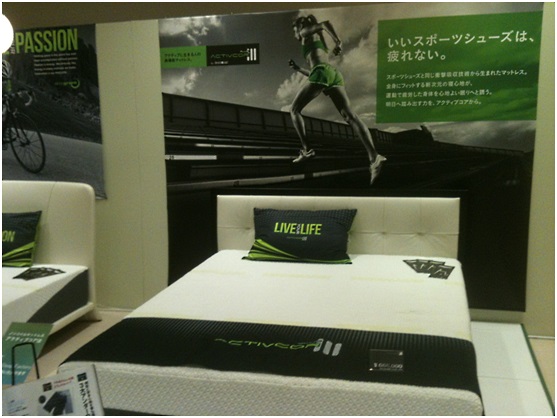

Nothing soft and fluffy about this positioning – “Activor, the next generation in sleep technology.” Hi-tech performance for the modern Japanese consumer.
Feeling inspired? Whatever your category, you can find inspiration from taking a completely different perspective.
P.S. Aussie mattress brand repositions for export market
Local mattress maker A H Beard has just launched in China. Unencumbered by any legacy in this new market, how are they differentiating? Their first mattress for Chinese consumers retails for over $20,000. That should set them apart.
Read MoreVale Scott Kennedy – one of NZ's finest artists
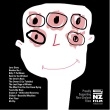
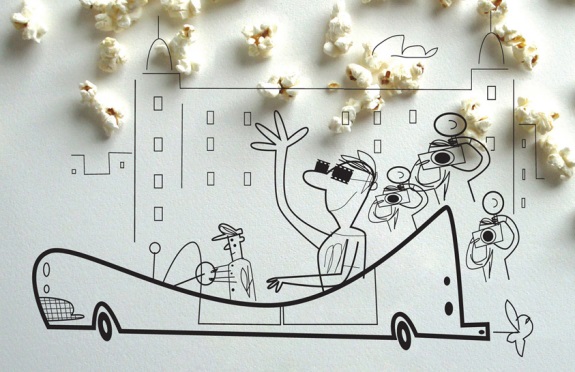
Our professional careers are sometimes touched by the most inspiring personal relationships. I was blessed with the early entry into my life as an Art Director by an artistic genius from across the ditch, Scott Kennedy. It was the early 80s and any Kiwi artist of promise had washed up in Sydney seeking a broader canvas.
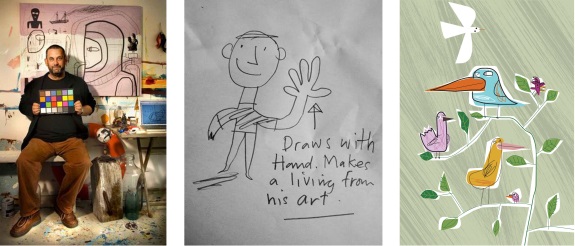
Scott bid us goodbye last week after a painful but defiantly good-humoured fight with cancer. At the end his hands wouldn’t work, but Scott’s creativity was always alive in his one of a kind headspace.

As you can see Scott’s view of life was re-expressed through the lens of 60s cartoon characters and tin toy robots and Dr Strangelove. His ex-US Army dad had relocated the entire family from California to New Zealand in the belief it was the safest place to be when they dropped The Bomb.
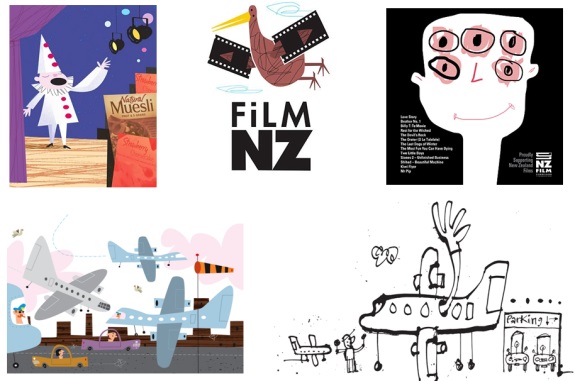
I loved Scott for his quirky humour, big heartedness and child like enthusiasm for new creative possibilities. Have a Captain Cook at Scott’s book covers for the popular How to… series, no surprises which is my favourite.
I write this while wearing Scott's "Joy kills sorrow" T-shirt, which is a fitting memorial to his precious time with us.
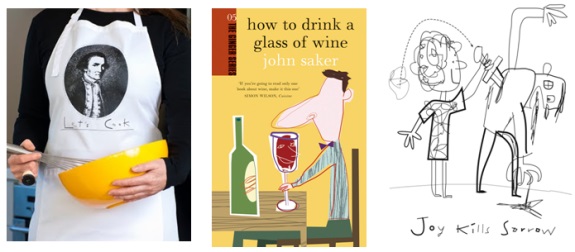
What CEOs want from an agency


The top 3 things CEOs and CMOs want from their agency according to a survey by the Communications Council are:
1. Innovation and creativity
2. Leadership
3. Integrity
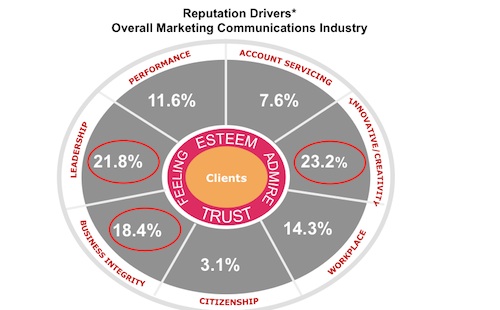
Funnily enough, the leaders of agencies put Leadership last.
Which could explain why three quarters of CEOs don't value marketers at the board level.
I wonder if this is a reflection of the transaction based relationships most agencies seem to be stuck in today. Whatever happened to “fearless advice”. It's what most left brain business managers want from right brain agency creative thinkers. Creative thought leadership is where agencies add value, not servile account management.
Perhaps it’s a consequence of a co-dependent relationship between ignorant brand managers and subservient suppliers. Meanwhile the smart business leaders appreciate the real value to be added is at the board level, with lateral and entrepreneurial advisors from outside their organisation helping them challenge traditional business models.
Read More




Scan the QR code for our contact details.
Download the Neoreader app.
© COPYRIGHT 2013 UNO marcomms Privacy